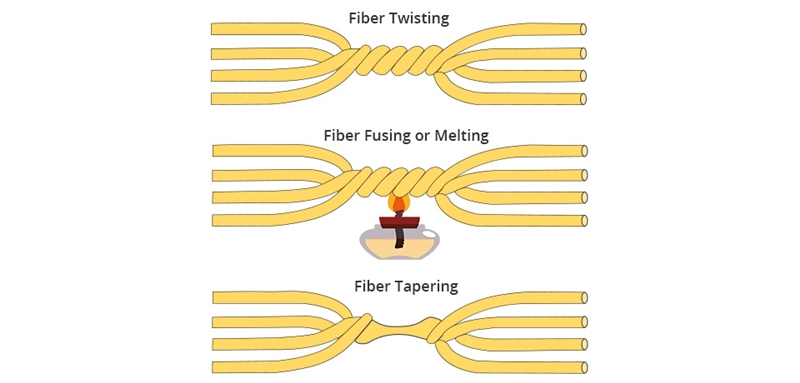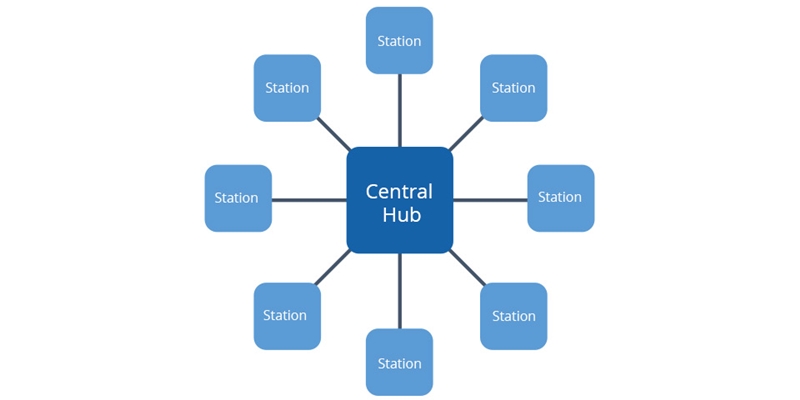How Do Different Fiber Optic Couplers Work?
What Is Fiber Optic Coupler?
Fiber optic coupler is one type of fiber optic component that allows for the redistribution of optical signals. It covers a wide range of fiber optic devices such as optical splitters, optical combiners, and optical couplers. A fiber optic coupler is a device that can distribute the optical signal from one fiber among two or more fibers, or combine the optical signal from two or more fibers into a single fiber.
Usually, optical signals are attenuated more in an optical coupler than in a connector or a splice because the input signal is not directly transmitted from one fiber to another, but divided among the output ports. For instance, with a 1 x 2 fiber optic coupler, each output is less than one-half of the power of the input signal (over a 3dB loss).
Different Fiber Optic Coupler Types
A basic fiber optic coupler has N input ports and M output ports. N and M typically range from 1 to 64. The number of input ports and output ports varies depending on the intended application for the coupler. Under different principles, fiber optic couplers can be categorized differently. The different types of optical couplers will be explored in the following part.

Classified by Manufacturing Technologies
Technologies used for constructing optical couplers can be complex and difficult to understand. Three major manufacturing techniques are micro-optics, fused-fiber, and planar waveguide.
Micro-optics couplers use individual optical elements such as prisms, lens, mirrors, etc. to construct an optical route. These elements divide the input optical signal into two or more separated light beams.
Fused-fiber couplers used the most basic material–optical fiber. Two or more fiber cores are twisted, fused and tapered together in a length.
Planar waveguides are more like a semiconductor. A planar wafer is used to make a waveguide coupler, and the reflections occur only in y-directions. Planar waveguides are more often used to make high port count couplers, such as 1 x 12 PLC splitter, 1 x 24 PLC splitter.

Classified by Shape
If we see optical couplers by shape, there is Y coupler, T coupler, X coupler, star coupler and tree coupler, which split the optical signal based on the power.
Y Coupler
A Y coupler resembles the letter Y. Y coupler also called optical tap coupler. The input signal is split into two output fibers. Sometimes, to meet users' specific applications, the power distribution ratio also can be controlled precisely.

T Coupler
Unlike the Y coupler, a T coupler has an uneven power distribution. The power of one output signal is greater than the other output signal. Popular splitting ratios include 10:90 percent and 20:80 percent. This optical coupler is often used in small networks with less port counts.

X Coupler (2x2)
X couplers carry out the function of a splitter and a combiner in one package. The X coupler combines and divides the optical power from the two input fibers between the two output fibers. Another name for the X coupler is 2 x 2 coupler.

Star Coupler
A star coupler generally has several input and output port combinations, in which the optical power is distributed from more than two input ports among several output ports. The number of input and output ports may or may not be equal in star couplers such as 2×4, 4×4, 8×16, etc. However, in all possible input and output port combinations, the distribution of power among the output ports remains equal.

Tree Coupler
A tree coupler is also a multiport coupler. It splits optical power from one input fiber to more than two output fibers. A tree coupler may also be used reversely to combine the optical signal from more than two input fibers to one output fiber.

Classified by Bandwidth or Window
Bandwidth or Window is also a factor to consider when users choose the optical coupler types. Regardless of the port types used, fiber optic couplers can be designed for single window, dual wavelength or wideband transmissions.
-
Single window couplers are designed to incorporate a single wavelength within a narrow wavelength window.
-
Dual-wavelength couplers have wider wavelength windows and can work with two wavelengths at a time.
-
Wideband couplers can be designed to work with a single wavelength covering a wider range of wavelengths.
In addition, fiber optic coupler also can be classified to single mode optical coupler and multimode optical coupler.
Applications of Fiber Optic Couplers
In local area network (LAN) applications, fiber optic couplers are used in either bus architecture or star architecture.
In a star network topology, the stations branch off from a central hub, much like the spokes on a wheel. Each network device connected by the star coupler can communicate with each other. Besides, the star coupler makes it easy to expand the number of workstations. For example, changing from a 4 x 4 to 8 x 8 doubles the system capacity.

Bus architecture utilizes T couplers to connect a series of stations to a single backbone cable. In a typical bus network topology, the T coupler at each node splits off part of the power from the bus and carries it to the attached equipment.

Tree couplers are typically used in cascaded PON architecture. The first tree coupler is directly connected to the optical line terminal (OLT) port in the central office, then each of the output fibers is routed to a tree coupler in other sites (outside enclosure/terminal box). If there’s a need to further divide the signal, more tree couplers can be added. Of course, other amplification or compensation modules are required to ensure the transmission.

Confusing Question About Fiber Optic Coupler
Passive Coupler vs. Active Coupler
Optical couplers can be either passive or active devices. Passive fiber optic couplers require no power for operation. The difference between passive and active couplers is that a passive coupler redistributes the optical signal without optical-to-electrical conversion. Active fiber optic couplers require an external power source. They are electronic devices that split or combine the signal electrically and use fiber optic detectors and sources for input and output. Most fiber optic couplers we’ve seen in optical links are passive devices, such as passive optical splitter and multiplexer (Mux) or de-multiplexer (Demux) in wavelength-division multiplexing (WDM) networks.
Optical Coupler vs Optical Splitter vs Optical Combiner
Optical couplers, optical splitter, and optical combiner are optical devices belonging to fiber optic couplers. Optical splitters are usually Y couplers, T couplers, or tree couplers that have only one input port and two or more output ports. On the contrary, optical combiners have only one output port and two or more input ports. So you can also see the numeral “1” in the descriptions of optic splitters and combiners, like 1x2 fiber optic splitters/combiners, 1x4 splitter/combiners, and 1 x 64 splitters. However, for optical couplers, they can be in any form we have mentioned above, such as star couplers, 2x2 couplers, 1x4 couplers, tree couplers, etc. Each device is designed for its purpose.
You might be interested in
Email Address

-
PoE vs PoE+ vs PoE++ Switch: How to Choose?
May 30, 2024













